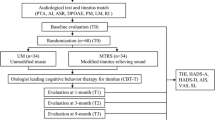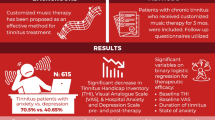Abstract
Objective
To study the psychoacoustic and audiological characteristics of patients with chronic subjective tinnitus and provide basis for the personalized diagnosis and treatment of tinnitus through a single tinnitus multielement integration sound therapy (T-MIST) and analysis of efficacy preliminarily.
Methods
145 patients with tinnitus were assessed by systematic medical history collection, professional examination of otolaryngology, audiology examination, full precision test (FPT), residual inhibition test (RIT), tinnitus handicap inventory (THI) and visual analog scale (VAS) annoyance. The correlation among factors was performed.
Results
The frequency of tinnitus was correlated with the frequency of maximum hearing loss (P < 0.05). The loudness of tinnitus was correlated with the loudness of maximum hearing loss (P < 0.05). In this study, T-MIST was used to treat tinnitus. After treatment, tinnitus alleviated VAS annoyance (P < 0.05). The results of RIT were correlated with the effect of T-MIST (P < 0.05).
Conclusion
There was a correlation between tinnitus and hearing loss. The RIT may indicate the effectiveness of acoustic therapy in patients. The FPT can find the hidden hearing loss without display on routine pure tone audiometry, so as to provide a clinical reference for the detection of early hearing loss in tinnitus patients.




Similar content being viewed by others
Data availability
The data used to support the findings of this study are available on request to the corresponding author: Jianming Yang, Email: Jmingyang88@163.com.
References
Clarke NA, Akeroyd MA, Henshaw H et al (2018) Association between subjective tinnitus and cognitive performance: protocol for systematic review and meta-analysis. BMJ Open. https://doi.org/10.1136/bmjopen-2018-023700
McCormack A, Edmondson-Jones M, Somerset S et al (2016) A systematic review of the reporting of tinnitus prevalence and severity. Hear Res 337:70–79. https://doi.org/10.1016/j.heares.2016.05.009
Bhatt IS (2018) Prevalence of and risk factors for tinnitus and tinnitus-related handicap in a college-aged population. Ear Hear 39:517–526. https://doi.org/10.1097/AUD.0000000000000503
Swan AA, Nelson JT, Swiger B et al (2017) Prevalence of hearing loss and tinnitus in Iraq and Afghanistan veterans: a chronic effects of neurotrauma consortium study. Hear Res 349:4–12. https://doi.org/10.1016/j.heares.2017.01.013
Molini E, Faralli M, Calzolaro L et al (2014) Impact of identifying factors which trigger bothersome tinnitus on the treatment outcome in tinnitus retraining therapy. ORL J Otorhinolaryngol Relat Spec 76:81–88. https://doi.org/10.1159/000360994
Peelle JE, Wingfield A (2016) The neural consequences of age-related hearing loss. Trends Neurosci. 39:486–497. https://doi.org/10.1016/j.tins.2016.05.001
Sliwinska-Kowalska M, Zaborowski K (2017) WHO environmental noise guidelines for the european region: a systematic review on environmental noise and permanent hearing loss and tinnitus. Int J Environ Res Public Health. https://doi.org/10.3390/ijerph14101139
Rajan R, Irvine DR (1998) Neuronal responses across cortical field A1 in plasticity induced by peripheral auditory organ damage. Audiol Neurootol 3:123–144. https://doi.org/10.1159/000013786
Resnik J, Polley DB (2017) Fast-spiking GABA circuit dynamics in the auditory cortex predict recovery of sensory processing following peripheral nerve damage. Elife. https://doi.org/10.7554/eLife.21452
Hullfish J, Abenes I, Kovacs S et al (2018a) Functional brain changes in auditory phantom perception evoked by different stimulus frequencies. Neurosci Lett 683:60–167. https://doi.org/10.1016/j.neulet.2018.07.043
Hullfish J, Abenes I, Kovacs S et al (2018b) Functional connectivity analysis of fMRI data collected from human subjects with chronic tinnitus and varying levels of tinnitus-related distress. Data Brief 21:779–789. https://doi.org/10.1016/j.dib.2018.10.044
Makar SK, Mukundan G, Gore G (2017) Treatment of tinnitus: a scoping review. Int Tinnitus J 21:144–156. https://doi.org/10.5935/0946-5448.20170027
Lee HY, Choi MS, Chang DS et al (2017) Combined bifrontal transcranial direct current stimulation and tailor-made notched music training in chronic tinnitus. J Audiol Otol 21:22–27. https://doi.org/10.7874/jao.2017.21.1.22
Cai Y, Zhou Q, Yang H et al (2017a) Logistic regression analysis of factors influencing the effectiveness of intensive sound masking therapy in patients with tinnitus. BMJ Open. https://doi.org/10.1136/bmjopen-2017-018050
Kam AC, Cheung AP, Chan PY et al (2009) Psychometric properties of the Chinese (Cantonese) Tinnitus Handicap Inventory. Clin Otolaryngol 34:309–315. https://doi.org/10.1111/j.1749-4486.2009.01946.x
Lu D, Chen XP and Liang J, et al (2019) The application of accurate clinical diagnosis and treatment with T-MIST in tinnitus patients. Lin Chung Er Bi Yan Hou Tou Jing Wai Ke Za Zhi 33: 128–131 https://doi.org/10.13201/j.issn.1001-1781.2019.02.009.
Roberts LE (2007) Residual inhibition. Prog Brain Res 166:487–495. https://doi.org/10.1016/S0079-6123(07)66047-6
Zhao Y, Zhao F, El RA et al (2019) The Long-term Effectiveness of Tinnitus Multivariate Integrated Sound Therapy (T-MIST) in 148 tinnitus patients with normal hearing thresholds: Our initial experience. Clin Otolaryngol 44:1156–1161. https://doi.org/10.1111/coa.13426
Liu Y, Qi J, Chen X et al (2019) Critical role of spectrin in hearing development and deafness. Sci Adv. https://doi.org/10.1126/sciadv.aav7803
Liu L, Chen Y, Qi J et al (2016) Wnt activation protects against neomycin-induced hair cell damage in the mouse cochlea. Cell Death Dis. https://doi.org/10.1038/cddis.2016.35
Fan KQ, Li YY, Wang HL et al (2019) Stress-induced metabolic disorder in peripheral CD4(+) T cells leads to anxiety-like behavior. Cell 179:864–879. https://doi.org/10.1016/j.cell.2019.10.001
Zhang S, Zhang Y, Dong Y et al (2020) Knockdown of Foxg1 in supporting cells increases the trans-differentiation of supporting cells into hair cells in the neonatal mouse cochlea. Cell Mol Life Sci 77:1401–1419. https://doi.org/10.1007/s00018-019-03291-2
C KD, Wan G, Cassinotti L et al (2020) Hidden hearing loss: a disorder with multiple etiologies and mechanisms. Cold Spring Harb Perspect Med. https://doi.org/10.1101/cshperspect.a035493
Tepe V, Smalt C, Nelson J et al (2017) Hidden hearing injury: the emerging science and military relevance of cochlear synaptopathy. Mil Med 182:e1785–e1795. https://doi.org/10.7205/MILMED-D-17-00025
Moore BC, Vinay, Sandhya (2010) The relationship between tinnitus pitch and the edge frequency of the audiogram in individuals with hearing impairment and tonal tinnitus. Hear Res 261: 51-56. https://doi.org/10.1016/j.heares.2010.01.003
Rauschecker JP, Leaver AM, Muhlau M (2010) Tuning out the noise: limbic-auditory interactions in tinnitus. Neuron 66:819–826. https://doi.org/10.1016/j.neuron.2010.04.032
Rauschecker JP, May ES, Maudoux A et al (2015) Frontostriatal gating of tinnitus and chronic pain. Trends Cogn. Sci. 19:567–578. https://doi.org/10.1016/j.tics.2015.08.002
Londero A, Langguth B, De Ridder D et al (2006) Repetitive transcranial magnetic stimulation (rTMS): a new therapeutic approach in subjective tinnitus? Neurophysiol Clin 36:145–155. https://doi.org/10.1016/j.neucli.2006.08.001
Jastreboff PJ, Jastreboff MM (2003) Tinnitus retraining therapy for patients with tinnitus and decreased sound tolerance. Otolaryngol Clin North Am 36:321–336. https://doi.org/10.1016/s0030-6665(02)00172-x
Searchfield GD, Durai M, Linford T (2017) A State-of-the-art review: personalization of tinnitus sound therapy. Front Psychol 8:1599. https://doi.org/10.3389/fpsyg.2017.01599
Karimi BM, Mahmoudian S, Jarollahi F (2020) The investigation of semantic memory deficit in chronic tinnitus: a behavioral report. Braz J Otorhinolaryngol 86:185–190. https://doi.org/10.1016/j.bjorl.2018.11.003
Kloostra F, Arnold R, Hofman R et al (2019) Models to predict positive and negative effects of cochlear implantation on tinnitus. Laryngoscope Investig Otolaryngol 4:138–142. https://doi.org/10.1002/lio2.224
Kreuzer PM, Poeppl TB, Rupprecht R et al (2017) Individualized repetitive transcranial magnetic stimulation treatment in chronic tinnitus? Front Neurol 8:126. https://doi.org/10.3389/fneur.2017.00126
O’Brien DC, Robinson AD, Wang N et al (2019) Transdermal lidocaine as treatment for chronic subjective tinnitus: A pilot study. Am J Otolaryngol 40:413–417. https://doi.org/10.1016/j.amjoto.2019.03.009
Kuzucu I, Karaca O (2020) Acupuncture treatment in patients with chronic subjective tinnitus: a prospective, randomized study. Med Acupunct 32:24–28. https://doi.org/10.1089/acu.2019.1367
Elzayat S, Ragab S, Eisa M et al (2018) Evaluation of adding lidocaine to dexamethasone in the intra-tympanic injection for management of tinnitus: a prospective, randomized controlled double-blinded Trial. Int Tinnitus J 22:54–59. https://doi.org/10.5935/0946-5448.20180009
Ralli M, Greco A, Turchetta R et al (2017) Somatosensory tinnitus: Current evidence and future perspectives. J Int Med Res 45:933–947. https://doi.org/10.1177/0300060517707673
Lanting CP, de Kleine E, van Dijk P (2009) Neural activity underlying tinnitus generation: results from PET and fMRI. Hear Res 255:1–13. https://doi.org/10.1016/j.heares.2009.06.009
Hoare DJ, Searchfield GD, El RA et al (2014) Sound therapy for tinnitus management: practicable options. J. Am Acad Audiol 25:62–75. https://doi.org/10.3766/jaaa.25.1.5
Acknowledgements
We would like to thank all participants for their time during this study.
Funding
The study was supported by funding from the Incubation Program of National Natural Science Foundation of China [Grant No. 2019GMFY06].
Author information
Authors and Affiliations
Corresponding author
Ethics declarations
Conflicts of interest
The authors declare that they have no conflicts of interest.
Additional information
Publisher's Note
Springer Nature remains neutral with regard to jurisdictional claims in published maps and institutional affiliations.
Rights and permissions
About this article
Cite this article
Yan, L., Wang, W., Wu, X. et al. Clinical characteristics of subjective idiopathic tinnitus and preliminarily analyses for the effect of tinnitus multielement integration sound therapy. Eur Arch Otorhinolaryngol 278, 4199–4207 (2021). https://doi.org/10.1007/s00405-020-06501-x
Received:
Accepted:
Published:
Issue Date:
DOI: https://doi.org/10.1007/s00405-020-06501-x




